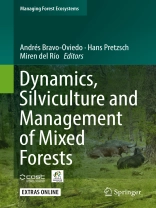The capacity of mixed forests to mitigate climate change effects by increasing resilience and lowering risks is pinpointed as an opportunity to highlight the role of tree species rich forests as part of complex socio-ecological systems.
This book updates and presents the state-of-the-art of mixed forest performance in terms of regeneration, growth, yield and delivery of ecosystem services. Examples from more than 20 countries in Europe, North Africa and South America provide insights on the interplay between structure and functionining, stability, silviculture and optimization of management of this type of forests. The book also analyses the role of natural mixed forests and mixed plantations in the delivery of ecosystem services and the best modelling strategy to study mixed forest dynamics.
The book is intended to serve as a reference tool for students, researchers and professionals concerned about the management of mixed forests in a context of social and environmental change.
Table of Content
Foreword.- 1. The Role of Mixed Forests in a Changing Social-Ecological World;
A. Bravo-Oviedo.- 2. Characterization of Mixed Forests;
M. del Río et al.- 3. Data Platforms for Mixed Forests Research: Contributions from the Eu MIXFOR Network;
R. Ruiz-Peinado et al.- 4. Regeneration Patterns in Mixed-Species Stands;
M. Löf et al.- 5. Growth and Structure in Mixed-Species Stands Compared with Monocultures. Review and Perspectives;
H. Pretzsch.- 6. Silviculture of Mixed Forests. A European Overview of Current Practices and Challenges;
M. Pach et al.- 7. The Development of Silvicultural Guidelines for Creating Mixed Forests;
W.L. Mason et al.- 8. Silviculture of Temperate Mixed Forests from South-America;
G.A. Loguercio et al.- 9. Mixed Forests Plantations;
J. Urgoiti, A. Paquette.- 10. Models for Mixed Forests;
M. Fabrika et al.- 11. Optimizing the Management of European Mixed Forests;
L. Valsta, J. Bredahl Jacobsen.- 12. Mixed Forests Future;
A. Bravo-Oviedo et al.- Index.












